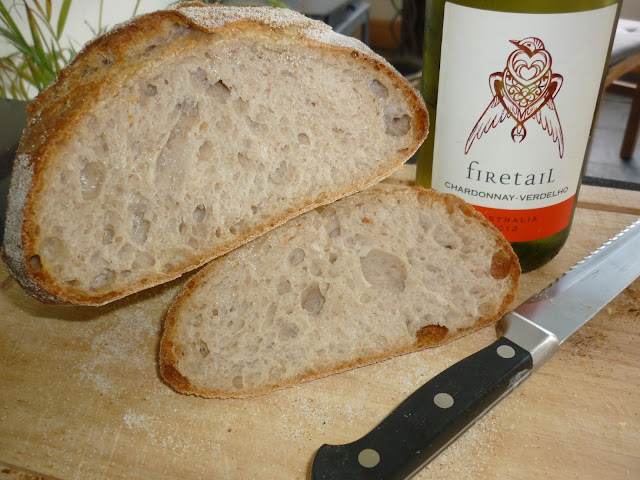 This month Bread Baking Babe Tanna from My Kitchen In Half Cups chose us a recipe to bake crunchy crackers. I never managed to get crackers crunchy, so was very happy to have a go. The original recipe asked for a mix of white whole wheat and unbleached all purpose flour, but any mixture of flours of your choice would do.
This month Bread Baking Babe Tanna from My Kitchen In Half Cups chose us a recipe to bake crunchy crackers. I never managed to get crackers crunchy, so was very happy to have a go. The original recipe asked for a mix of white whole wheat and unbleached all purpose flour, but any mixture of flours of your choice would do.I immediately thought "CHEESE" when reading the recipe. Crunchy seedy crackers NEED cheese. I decided to top the first batch of the crackers with grated gruyère. Big success! The smell, the taste, fantastic! No extra topping needed.
The second batch unfortunately ended up in the bin.
The dough had sat in the fridge for a couple of hours, being very cold rolled out beautifully, but being in a hurry I grabbed flaked sea salt in stead of cheese (what was I thinking) for the topping. I overdid it big time. Way too salty, inedible (but soooo crunchy and good looking).
I'll definitely bake these crackers again. With different mixtures of flours and different toppings, but the seedy cheesy crunchy variety will be baked and eaten over and over again here!
Recipe adapted from King Arthur Flour:
 |
| Binned .... |
1 tsp instant yeast
170 gr Whole Wheat Flour
60 gr Strong White Bread Flour
60 gr AP flour
1 tbs sugar
1 tsp salt
14 gr ground flax seed
14 gr sesame seed
10 gr olive oil
188 gr water
TOPPING
mixed seeds (sunflower, pumpkin, sesame, poppy, flax, etc.)
grated gruyère cheese
METHOD
Put all dough ingredients in the pan of a bread maker and choose "Dough" program (mine takes 2.20 hours, including first rise).
Take the dough out and divide in half. Working with one piece at the time, roll it into a rectangle as thinly as you can. The thinner the dough the crunchier the crackers! If the dough fights back; give it 10 mins. rest and roll again. Put the other half of the dough in the fridge (in a plastic bag) to use later. I found rolling the cold dough was even easier!
Turn the dough onto a piece of baking paper and spritz with water. Sprinkle with a quarter of your seed mixture. Lay a piece of baking paper on top and press the seeds in with a rolling pin. Turn the dough over, peel off baking paper and repeat, but also add gruyere cheese. Again top the dough with baking paper and press in seeds and cheese with a rolling pin. Peel off the top layer of baking paper.
Transfer the dough -with baking paper underneath- onto a baking sheet, prick it all over with a fork and cut the crackers into your desired shape and size (with a pizza cutter or normal knife. If you want to see a proper cracker cutting gadget check out Tanna's!) .
No need to separate the crackers, they easily brake apart after baking. Let the crackers rise (covered/in a plastic bag) for 30 - 45 minutes, while you preheat your oven (170ºC fan). They'll get just a bit puffy.
Bake for 20 minutes until the crackers are a medium brown. Turn off the heat, wait 15 minutes then put the oven door ajar and let the crackers cool completely. When they're completely cool, break apart and .... ENJOY!






































